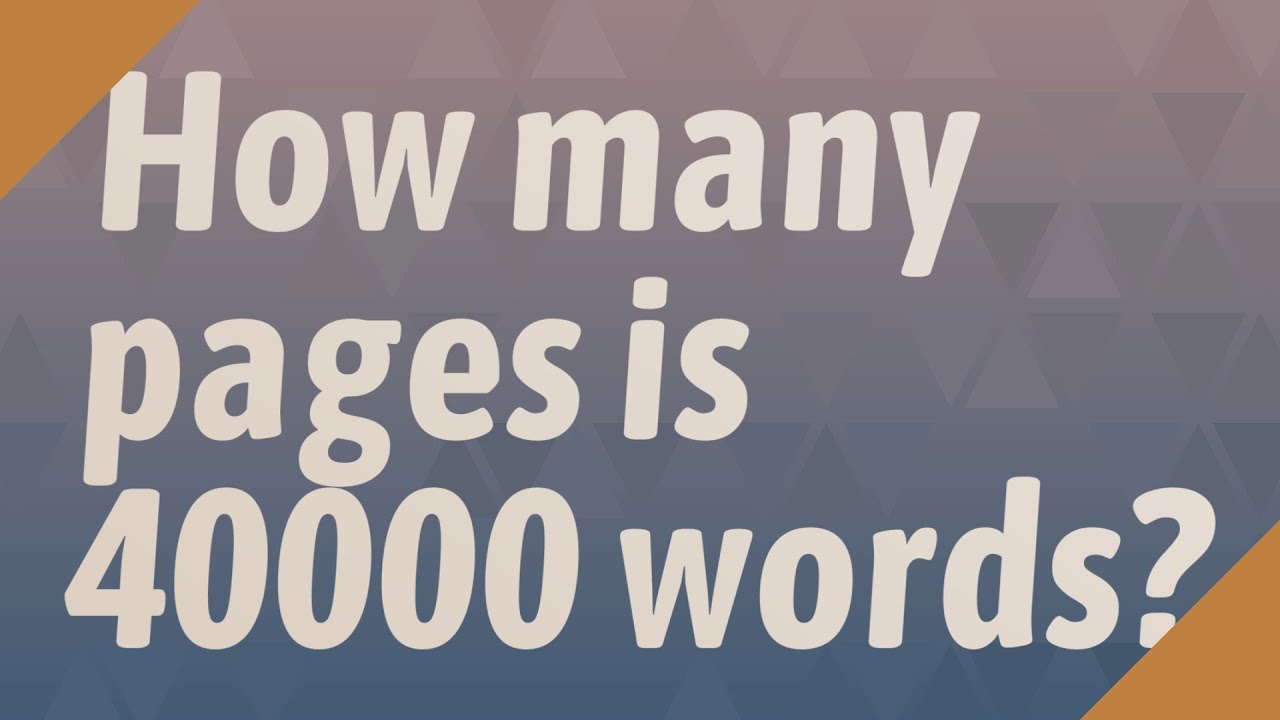How Many Pages Is 40,000 Words?
Ever wondered how many pages 40,000 words would fill? Well, buckle up and get ready for an answer that will leave you amazed! In this article, we’re going to dive deep into the world of word counts and page lengths to uncover the mystery behind the question, “How many pages is 40,000 words?” So, grab a cup of coffee and let’s embark on this literary adventure together!
Now, I know you’re probably itching to find out the exact number of pages 40,000 words would occupy, but before we get there, let’s talk about the factors that can influence the answer. The truth is, there isn’t a one-size-fits-all answer to this question. The number of pages 40,000 words can fill can vary depending on various factors such as font size, formatting, margins, and spacing. So, while I can’t give you an exact number just yet, I promise we’ll get there soon enough!
So, whether you’re a writer curious about the length of your masterpiece or simply a curious reader with an insatiable thirst for knowledge, stick around as we unravel the secrets of page counts and word numbers. By the end of this article, you’ll have a clear understanding of how many pages 40,000 words can occupy, and you’ll be armed with the knowledge to impress your friends at your next book club meeting. Let’s get started, shall we?
Wondering how many pages 40,000 words would fill? The number of pages can vary depending on various factors such as font size, spacing, and formatting. However, as a general estimate, a 40,000-word document would roughly fill about 80-160 pages. Keep in mind that this is just an approximation, and the final page count may differ based on the specific requirements and layout of your document.

How Many Pages is 40,000 Words?
The Length of a 40,000-Word Document
When it comes to writing, one of the common questions that often arises is, “How many pages is 40,000 words?” The answer to this question depends on several factors, such as font size, line spacing, and margins. However, to give you a general idea, a 40,000-word document typically spans around 80 to 160 pages.
The length of a document can vary significantly based on the specific requirements and formatting guidelines. For instance, academic papers often have specific formatting requirements, such as double-spacing and specific font choices, which can affect the overall page count. On the other hand, novels or non-fiction books may use different formatting options that can alter the number of pages.
Factors That Determine Page Count
Several factors influence the number of pages in a 40,000-word document. Here are a few key factors to consider:
1. Font Size and Style
The font size and style used in a document play a crucial role in determining the number of pages. Larger fonts generally take up more space, resulting in fewer words per page. Conversely, smaller fonts can fit more words on a page, increasing the overall page count.
2. Line Spacing
Line spacing is another critical factor that affects page count. Double-spacing is a common requirement for academic documents, making them easier to read and review. However, it also means that each page contains fewer words. Single-spacing, on the other hand, allows for more words per page, resulting in a higher page count.
3. Margins
The margins, or the blank spaces surrounding the text, also impact the number of pages. Wider margins reduce the available space for text, leading to a higher page count. Conversely, narrower margins increase the space for text, resulting in a lower page count.
4. Formatting Requirements
Specific formatting requirements, such as headers, footers, and title pages, can add extra pages to a document. These elements often contribute to the overall structure and presentation of the work but do not contain the main body of the text.
Comparing Page Counts for Different Document Types
The page count for a 40,000-word document can vary depending on the type of writing and its intended purpose. Here’s a comparison of page counts for different document types:
1. Novels and Fiction Books
In the world of fiction, a 40,000-word document typically spans around 160 to 200 pages. Novels often have fewer words per page compared to academic or technical documents. This is because novels use larger font sizes, wider margins, and line spacing that is more visually appealing to readers.
2. Academic Papers
For academic papers, the page count of a 40,000-word document can range from 80 to 120 pages. Academic papers often require specific formatting guidelines, such as double-spacing and smaller fonts, which result in more words per page compared to novels.
3. Business Reports or Technical Documents
Business reports or technical documents usually have a higher word count per page due to smaller font sizes, single-spacing, and narrower margins. As a result, a 40,000-word document in this genre may only span around 60 to 80 pages.
Factors to Consider Beyond Page Count
While page count is an essential consideration, it’s important to remember that the quality and content of the writing matter more than the number of pages. Factors such as the clarity of ideas, coherence, and organization play a significant role in creating impactful written work.
When writing, it’s crucial to focus on effectively conveying the intended message and engaging the reader, rather than fixating solely on the number of pages. Ultimately, the goal should be to produce high-quality content that captures the reader’s attention and provides valuable information.
Conclusion
In conclusion, the number of pages in a 40,000-word document can vary depending on several factors, including font size, line spacing, and margins. Novels typically have around 160 to 200 pages for this word count, while academic papers range from 80 to 120 pages. Business reports or technical documents may only span around 60 to 80 pages. However, it’s important to remember that page count is not the sole indicator of the quality or impact of a written work. The focus should be on creating engaging and valuable content that resonates with the reader.
Key Takeaways: How many pages is 40,000 words?
- 40,000 words is approximately 80 pages when using a standard font and font size.
- This estimation may vary depending on formatting, spacing, and other factors.
- Average book pages range from 250-300 words per page, so 40,000 words would be around 133-160 pages.
- Keep in mind that these numbers are just estimates and can differ from actual page counts.
- It’s always a good idea to consult the specific guidelines or requirements of your project or publisher for accurate page count expectations.
Frequently Asked Questions
Here are some common questions about the number of pages for 40,000 words:
Question 1: How many pages is 40,000 words when using standard formatting?
When it comes to standard formatting, the number of pages for 40,000 words can vary. However, a general estimate would be around 80 to 160 pages. The exact number of pages will depend on factors such as font size, line spacing, and margins.
It’s important to note that different publishers or institutions may have specific guidelines for formatting, so the number of pages can vary in those cases as well.
Question 2: How does font size affect the number of pages for 40,000 words?
Font size plays a significant role in determining the number of pages for 40,000 words. Generally, smaller font sizes result in more words fitting on a page, which means more pages overall. On the other hand, larger font sizes may result in fewer words per page and, consequently, fewer total pages.
It’s worth considering the readability and legibility of the text when choosing a font size. While a smaller font size may increase the number of pages, it shouldn’t compromise the readability of the content.
Question 3: How does line spacing affect the number of pages for 40,000 words?
Line spacing, also known as leading, is another factor that can impact the number of pages for 40,000 words. The space between lines can vary, and it determines how much vertical space each line of text occupies. Different line spacing options, such as single-spacing or double-spacing, can significantly affect the layout of the text.
In general, using wider line spacing will result in more pages, as each line of text takes up more vertical space. Conversely, narrower line spacing will lead to fewer pages, as more lines can fit on each page.
Question 4: How does margin size affect the number of pages for 40,000 words?
Margins are the empty spaces surrounding the text on a page. The size of the margins can influence the number of pages for 40,000 words. Wider margins mean less space for text, resulting in more pages, while narrower margins allow more text to fit on each page, resulting in fewer pages.
It’s important to strike a balance between aesthetics and readability when choosing margin sizes. While narrower margins may increase the number of words per page, overly narrow margins can make the text appear crowded and difficult to read.
Question 5: Are there any other factors that can impact the number of pages for 40,000 words?
Yes, there are other factors that can affect the number of pages for 40,000 words. These include the presence of images, tables, or other visual elements within the text. Including such elements may increase the overall page count, as they take up space alongside the written content.
Additionally, the specific formatting requirements of a publisher or institution can also impact the number of pages. Some may have specific guidelines for chapter headings, subheadings, or other elements that contribute to the overall page count.
How many pages is 40000 words?
Final Summary: How many pages is 40,000 words?
So there you have it, my fellow word enthusiasts. We’ve embarked on a journey to unravel the mystery of how many pages 40,000 words would fill. After diving deep into the realms of word count, page layout, and font size, we’ve arrived at a satisfying conclusion.
In our quest for knowledge, we discovered that the number of pages can vary depending on several factors. The type of document, font style, font size, line spacing, and margins all play a role in determining the final page count. However, as a general guideline, 40,000 words would likely span around 160 to 200 pages in a standard novel format.
Now, before you embark on your own writing adventure, keep in mind that these calculations are not set in stone. Remember, writing is an art form, and the beauty lies in the flexibility and creativity it allows. So, whether you’re crafting a gripping novel, a comprehensive report, or a heartfelt letter, let your words flow freely, and worry less about the precise number of pages they occupy.
In the end, what truly matters is the impact your words have on the reader. So, go forth and write fearlessly, my friends. Express yourself, captivate your audience, and let your words leave an indelible mark on the world. Happy writing!






